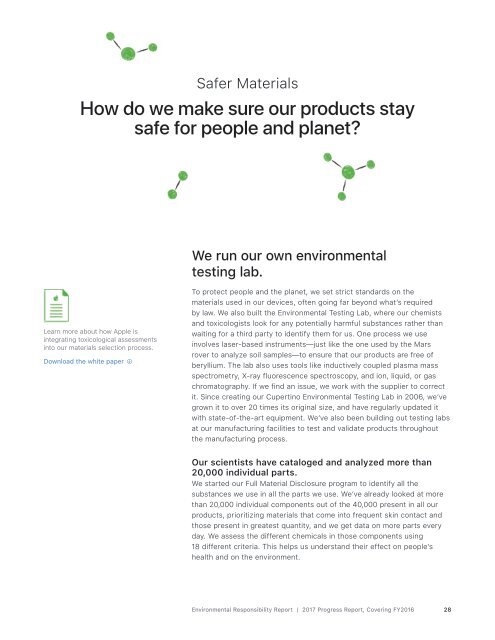Apple Environmental Responsibility Report
You also want an ePaper? Increase the reach of your titles
YUMPU automatically turns print PDFs into web optimized ePapers that Google loves.
Safer Materials<br />
How do we make sure our products stay<br />
safe for people and planet?<br />
We run our own environmental<br />
testing lab.<br />
Learn more about how <strong>Apple</strong> is<br />
integrating toxicological assessments<br />
into our materials selection process.<br />
Download the white paper ↓ ⃝<br />
To protect people and the planet, we set strict standards on the<br />
materials used in our devices, often going far beyond what’s required<br />
by law. We also built the <strong>Environmental</strong> Testing Lab, where our chemists<br />
and toxicologists look for any potentially harmful substances rather than<br />
waiting for a third party to identify them for us. One process we use<br />
involves laser-based instruments—just like the one used by the Mars<br />
rover to analyze soil samples—to ensure that our products are free of<br />
beryllium. The lab also uses tools like inductively coupled plasma mass<br />
spectrometry, X-ray fluorescence spectroscopy, and ion, liquid, or gas<br />
chromatography. If we find an issue, we work with the supplier to correct<br />
it. Since creating our Cupertino <strong>Environmental</strong> Testing Lab in 2006, we’ve<br />
grown it to over 20 times its original size, and have regularly updated it<br />
with state-of-the-art equipment. We’ve also been building out testing labs<br />
at our manufacturing facilities to test and validate products throughout<br />
the manufacturing process.<br />
Our scientists have cataloged and analyzed more than<br />
20,000 individual parts.<br />
We started our Full Material Disclosure program to identify all the<br />
substances we use in all the parts we use. We’ve already looked at more<br />
than 20,000 individual components out of the 40,000 present in all our<br />
products, prioritizing materials that come into frequent skin contact and<br />
those present in greatest quantity, and we get data on more parts every<br />
day. We assess the different chemicals in those components using<br />
18 different criteria. This helps us understand their effect on people’s<br />
health and on the environment.<br />
<strong>Environmental</strong> <strong>Responsibility</strong> <strong>Report</strong> | 2017 Progress <strong>Report</strong>, Covering FY2016<br />
28







